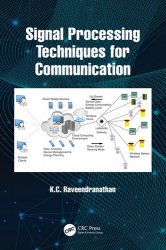 Название: Signal Processing Techniques for Communication Название: Signal Processing Techniques for Communication
Автор: Raveendranathan K.C.
Издательство: CRC Press
Год: 2025
Страниц: 315
Язык: английский
Формат: pdf (true), epub
Размер: 24.7 MB
The reference text discusses signal processing tools and techniques used for the design, testing, and deployment of communication systems. It further explores software simulation and modeling tools like MATLAB, GNU Octave, Mathematica, and Python for modeling, simulation, and detailed analysis leading to comprehensive insights into communication systems. The book explains topics such as source coding, pulse demodulation systems, and the principle of sampling and aliasing. This book: Discusses modern techniques including analog and digital filter design, and modulation principles including quadrature amplitude modulation, and differential phase shift keying. Covers filter design using MATLAB, system simulation using Simulink, signal processing toolbox, linear time-invariant systems, and non-linear time-variant systems. Explains important pulse keying techniques including Gaussian minimum shift keying and quadrature phase shift keying. Presents signal processing tools and techniques for communication systems design, modeling, simulation, and deployment. Illustrates topics such as software-defined radio (SDR) systems, spectrum sensing, and automated modulation sensing. The text is primarily written for senior undergraduates, graduate students, and academic researchers in the fields of electrical engineering, electronics and communication engineering, Computer Science, and engineering.
In Chapter 1, we begin with a study of fundamental concepts of systems and signals and various transforms of signals and progress to the application of Digital Signal Processing tools in the design of communication subsystems. In Chapter 2, we explore software simulation and modeling tools like MATLAB, GNU Octave, Python, and Mathematica for the modeling, simulation and detailed analysis leading to comprehensive insights in Communication Systems. MATLAB and GNU Octave, as well as Mathematica are widely used software tools for the signal processing associated to communication systems. Python, on the otherhand, is the most widely used and popular programming language as reported by the IEEE. We will introduce the basics of these software tools giving short introduction to the associated programming structures. We will also give detailed pointers to programming using these softwares. Source code of a multitude of software simulations form an integral part of this book.
In the third chapter, we explore signal processing being done in frequency domain. Various transforms like Laplace transform, Fourier transform, z-transform, Discrete Cosine Transform (DCT), and Hilbert transform and their inverse transforms are discussed. The concept of convolution is introduced. The process of obtaining the output of an NLTV system is also brought out.
In Chapter 4, we discuss analog and digital modulation schemes like AM, AM-DSB, SSB, VSB, and pulse modulation schemes like PSK, QPSK, QAM, MSK, and GMSK, and its several variants, MIMO, TDMA, FDMA, CDMA, OFDM and other modern communication paradigms. Noise analysis, and modeling of noise in communication systems is a highly significant area in the study of signal theory and communication systems. We will extensively study the various noise models such as AWGN, Salt & Pepper noise, ISI, CCI, and various concepts associated with design of systems that can result in noise mitigation.
In Chapter 5, the design of analog subsystems is dealt with. The channel noise and various filters like LPF, HPF, BPF, BRF (notch filter) are discussed in detail. The design of analog filters using appropriate MATLAB tool kit is discussed. Digital filter design using MATLAB is the topic of discussion in Chapter 6. Quantization noise and design of LP, HP, BP, BR digital filters using MATLAB is done in this chapter.
Chapter 7 gives a detailed idea of modern communication systems. Multiple Input Multiple Output (MIMO) Systems and the tricks and techniques in the design of MIMO Systems are studied. Signal Processing in Wireless Communication is the subject matter of Chapter 8. CCI, ACI, ISI, as well as 5G and 6G mobile communication concepts are discussed.
Principles of advanced communication systems like SDMA, TDMA, FDMA, CDMA, OFDM, Software Defined Radio, Cognitive Radio Networks, and so on are discussed in Chapter 9. To some extent, satellite communication is also discussed. At the end modern wireless communication technologies such as IoT, RFID, LoRaWAN, WiFi HaLow, CPS, and Big Data are also studied.
In Chapter 10, a very relevant and recent topic is discussed. Machine Learning for Communication Systems is introduced. Machine Learning and Deep Learning techniques have wide applications in communication systems design. Software-Defined Radio (SDR) Systems, Spectrum Sensing, and Automated Modulation Sensing are also form part of this chapter.
We follow a as-simple-as-possible style of introducing the fundamental concepts in the entire textbook. A large number of solved problems, short-term projects/assignments, and end-of-chapter exercises are also included throughout the textbook.
Contents:
1. Introduction to Signals, Systems, and Processing.
2. System Simulation Tools.
2.1 Introduction to MATLAB & Simulink
2.2 Toolboxes and Blocksets in MATLAB
2.3 Filter Design Using MATLAB
2.4 System Simulation Using Simulink
2.5 MATLAB Online
2.6 Introduction to Mathematica
2.7 Introduction to GNU Octave
2.8 Introduction to Python
3. Signal Processing in Frequency Domain.
4. Introduction to Communication Systems.
5. Design of Analog Filters Using MATLAB.
6. Design of Digital Filters.
7. Introduction to Modern Communication Systems.
8. Signal Processing in Wireless Communication.
9. Advanced Communication Systems.
10. Machine Learning for Communication Systems.
Скачать Signal Processing Techniques for Communication
|